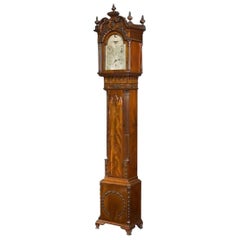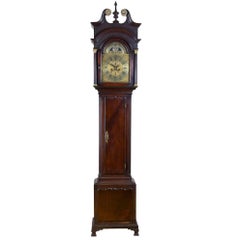Antique Tide Clocks
Early 1900s English Edwardian Antique Tide Clocks
Mahogany
Recent Sales
Late 18th Century English Chippendale Antique Tide Clocks
Mahogany
People Also Browsed
18th Century Irish George II Antique Tide Clocks
Mahogany
Late 19th Century Japanese Meiji Antique Tide Clocks
Enamel, Copper
1940s Swedish Scandinavian Modern Antique Tide Clocks
Fabric, Wood
19th Century American Federal Antique Tide Clocks
Wood
1780s Russian Regency Antique Tide Clocks
Gesso, Mirror, Wood, Giltwood
Late 19th Century French Belle Époque Antique Tide Clocks
Bronze, Ormolu
1820s French Louis Philippe Antique Tide Clocks
Gold Leaf
Late 19th Century French Belle Époque Antique Tide Clocks
Marble, Bronze, Ormolu
Late 19th Century French Belle Époque Antique Tide Clocks
Granite, Bronze, Ormolu
19th Century French Napoleon III Antique Tide Clocks
Crystal, Ormolu
1820s French Louis Philippe Antique Tide Clocks
Gold Leaf
Late 19th Century French Art Nouveau Antique Tide Clocks
Jade, Bronze
Mid-18th Century Swedish Rococo Antique Tide Clocks
Metal
1790s French Louis XVI Antique Tide Clocks
Silver Leaf
Late 19th Century Belle Époque Antique Tide Clocks
Crystal, Bronze
Mid-20th Century French Campaign Antique Tide Clocks
Metal
Finding the Right Grandfather-clocks-longcase-clocks for You
Antique grandfather clocks and longcase clocks are staples of old-world design sensibilities, and, along with their storied history, these statuesque timepieces can bring a feeling of warmth to living rooms, dining rooms and other areas of your home.
Longcase clocks, which originated in England and were manufactured in the United States beginning in the 1700s, refer to tall clocks with a face and clock works positioned high in the housing while a large swinging pendulum movement is tucked inside the case, which is supported by a carved base called a plinth.
While guests making their way through your foyer (another ideal location for such a furnishing) might typically refer to your longcase clock as a “grandfather clock,” there are actually three varieties of these stylish floor clocks, which include granddaughter clocks (the shortest, generally not one solid piece of wood and around three to five feet tall), grandmother clocks (the slimmer middle ground, between five feet and six feet tall) and grandfather clocks, which are typically between six and seven feet tall.
Sculptural and statement-making, antique grandfather clocks created by the likes of the Seth Thomas Clock Company, the Howard Miller Clock Company, Hermle or other clockmakers are an alluring choice in filling up space in a room, while the shorter longcase clocks are just as useful if you need an element that is comparatively muted or you’re working with limited space.
Each generation of artisan clockmakers, working in various furniture styles over time, contributed its own flourishes to the design of longcase clocks. Antique grandfather clocks in the Georgian style share commonalities with neoclassical design. They were often made in dark woods such as mahogany and feature intricate carving. Mahogany is also common for Victorian-era grandfather clocks, although examples of this style can be found in oak and walnut too. Designers of contemporary grandfather clocks are using a range of materials.
It’s easy to get confused when determining the origins or value of an antique grandfather clock or other vintage longcase clock. While an antique appraiser will be able to tell quickly, searching for a manufacturer’s name engraved on the face and dial of the clock may be an easy way to learn about the history of your clock.
Find a distinctive variety of antique grandfather clocks and longcase clocks on 1stDibs, and browse our collection of unusually beautiful clocks, wall clocks, desk clocks and other vintage clocks too.
- 1stDibs ExpertFebruary 27, 2024To identify your antique clock, search for markings on the back of its movement or case. Once you have located these marks, use trusted online resources to determine who the maker is. From there, you can continue your research to learn more about your clock's age, style and other characteristics. An expert appraiser or antiques dealer can also assist you with identification. Find a wide range of antique clocks on 1stDibs.
- 1stDibs ExpertApril 5, 2022Check the clock for a manufacturer’s mark or label. Once you have this, you should be able to look up the clock’s brand to see if it is French in origin. A clock is considered antique once it is 100 years old. A professional can also help verify the origin of your clock. Shop an array of expertly vetted antique clocks on 1stDibs.
- 1stDibs ExpertOctober 26, 2021An antique bracket clock refers to a portable spring-driven pendulum table clock created in the 17th and 18th centuries. These clocks were equipped with convenient carrying handles and were housed usually in rectangular cases. Shop a collection of antique and vintage bracket clocks from some of the world’s top dealers on 1stDibs.
- How can I spot an antique clock?1 Answer1stDibs ExpertApril 5, 2022To spot whether or not a clock is antique, note if the clockmaker’s name or company is engraved near the center face of the dial. A paper label may also be pasted on the back of the clock. You can shop a collection of expertly vetted antique clocks from some of the world’s top sellers on 1stDibs.
- 1stDibs ExpertFebruary 17, 2023To know if an antique clock is valuable, you'll typically need to have the piece assessed by a certified appraiser or an experienced antiques dealer. The maker and style of the clock will help determine its value (an early American clockmaker’s antique grandfather model, featuring an oak case and decorative carvings, may be very interesting to collectors, for example). Overall condition of your clock also plays a role. Generally, clocks that still work are worth more than those that require repairs. On 1stDibs, find a selection of antique, vintage and modern clocks.
- 1stDibs ExpertSeptember 16, 2024Yes, some old antique clocks may be worth something. Many collectors look for clocks produced by certain manufacturers, such as the Ansonia Clock Company, the Seth Thomas Clock Company, Jaeger-LeCoultre and the Chelsea Clock Company. In addition to the maker, the type, materials, style and condition of the clock influence its value. Generally, clocks that remain in good working order are worth more than those in need of repairs and restorations. To find out how much your clock may be worth, consult a certified appraiser or experienced antique dealer. On 1stDibs, explore a large collection of antique clocks.
Read More
How a Craving for Color Revolutionized Glass
After synthetic dyes changed fashion, home goods and printed matter, it was only a matter of time till glass caught up.
Kazuyo Sejima’s Flowering Tree Blooms Year-Round
The brilliantly simple design turns a modest bouquet into a major statement.
He Wrote ‘Oedipus Rex,’ but Do You Know What He Looked Like?
The Greek tragedian is said to have been handsome in his day.
Cigar Culture Was Once the Peak of Masculinity. Now, It’s a Compelling Curiosity
Even for those who don’t indulge, elegant smoking accessories and audacious art portraying cigar enthusiasts hold a nostalgic allure.
African Travel Plans on Hold? This Ardmore Leopard Vase Brings the Beauty of the Savanna to You
It’s an excellent example of the sought-after ceramics coming out of South Africa’s KwaZulu-Natal province.
With a High-Tech Flagship and Cool Collabs, Lladró Is Breaking the Mold for Porcelain Production
Thanks to its new leadership, the Spanish maker of figurines, busts and lighting is on a mission to update the art of porcelain for the 21st century.
Zoë Powell’s Magnolia 05 Vessel Is Handmade from Clay She Unearthed Herself
The free-form stoneware piece is inspired by the magnolia tree and its associations with home.
8 Ways to Breathe New Life into a Space with Plants
The pair behind the Instagram account @houseplantclub share their tips for making any room of the house gloriously green.

